Canada is introducing new work permit rules in 2025, offering more flexibility for individuals seeking to work without an employer’s involvement.
These changes are particularly beneficial for individuals who do not have a job offer but still wish to explore work opportunities in Canada. With new pathways like Open Work Permits, Self-Employed Visas, and Provincial Nominee Programs (PNPs), it’s now easier than ever to work in Canada independently.
This guide covers everything you need to know about the new rules, eligibility, and how to apply for a Canada work permit without needing employer sponsorship.
What is an Open Work Permit (OWP)?
An Open Work Permit (OWP) allows individuals to work for any employer in Canada without the need for a confirmed job offer or a Labor Market Impact Assessment (LMIA).
The OWP offers the flexibility to work in Canada and is particularly beneficial for individuals like freelancers, spouses of students, and workers in high-demand occupations.
| Eligibility Criteria for OWP | Who Can Apply |
|---|---|
| Spouses of International Students | Enrolled in master’s, doctoral, or professional degree programs (e.g., law, medicine) |
| Spouses of Temporary Foreign Workers (TFWs) | Must work in high-demand jobs (TEER 0, 1, 2, 3 categories) |
| Foreign workers with provincial support | Applicants from Alberta, Manitoba, Yukon, etc., with support letters |
Recent updates to the OWP rules in 2025 have made it easier for some applicants while restricting eligibility for others. Specifically, spouses of undergraduate and diploma students are no longer eligible, but there are extended opportunities in certain provinces, such as Alberta, Manitoba, and Yukon.
Pathways to Work in Canada Without Employer Sponsorship
- Post-Graduation Work Permit (PGWP)
The PGWP allows international students who graduate from a designated learning institution (DLI) in Canada to work without employer restrictions. The PGWP is valid for up to three years, depending on the length of the study program and offers a path to permanent residency (PR) through the Canadian Experience Class (CEC). Example: A graduate of a two-year master’s program in Canada will receive a three-year PGWP, enabling them to work anywhere in Canada. - Self-Employed Work Permit
Self-employed individuals, including freelancers, artists, entrepreneurs, and IT professionals, may be eligible for a Self-Employed Work Permit. Applicants must demonstrate they contribute to Canada’s economy or culture. Example: A photographer with international recognition or a tech entrepreneur looking to start a business in Canada could apply for this permit. - Provincial Nominee Programs (PNPs)
PNPs allow individuals to apply for a temporary work permit before obtaining permanent residency. Certain provinces have specific programs for skilled workers, enabling them to work while awaiting PR approval. 2025 Update: Applicants with a valid work permit and a PNP support letter can apply for a PNP-specific work permit. Example: A software engineer nominated by Alberta’s Tech Pathway could work while waiting for PR approval. - International Experience Canada (IEC)
The IEC Working Holiday Visa allows young professionals (18-35) from select countries to work in Canada without employer sponsorship. This open work permit is valid for up to two years. Example: A 28-year-old Australian can live and work in Canada for up to two years under this program.
How to Apply for a Canada Work Permit Without Employer Sponsorship
Applying for a work permit without employer sponsorship involves a few steps:
| Step | Action |
|---|---|
| Step 1: Determine Eligibility | Check which program applies to your situation: OWP, PGWP, Self-Employed, or PNP |
| Step 2: Gather Documents | Collect passport, educational credentials, proof of funds, and work experience (if applicable) |
| Step 3: Apply Online | Submit your application through the IRCC Portal |
| Step 4: Biometrics & Medical Exam | Provide biometrics and undergo a medical exam (if required) |
| Step 5: Wait for Processing | Wait for the decision, typically within 8-12 weeks depending on the program |
Canada’s 2025 work permit changes offer increased opportunities for individuals to work in the country without an employer’s involvement.
Whether through Open Work Permits, Self-Employed Visas, or Provincial Nominee Programs, these new rules allow more flexibility in securing a work permit.
By understanding the eligibility criteria and applying through the proper channels, you can successfully obtain a Canada work permit and take advantage of the career opportunities that await you.
FAQs
1. Can I apply for a work permit without a job offer?
Yes, you can apply for a work permit through programs like Open Work Permits, PGWP, or Self-Employed Visas, without needing a job offer.
2. How long is the Post-Graduation Work Permit (PGWP) valid for?
The PGWP is valid for up to three years, depending on the length of your study program in Canada.
3. Are there any restrictions on who can apply for the Open Work Permit (OWP)?
Yes, spouses of undergraduate students or diploma program participants are no longer eligible for the OWP under the new 2025 rules. However, there are extended opportunities in provinces like Alberta, Manitoba, and Yukon.

Can someone on visitors record apply
toyinbakre@hotmail.co.uk
If I am not fulfilled this gatogry. Is there any other opportunity?
I would like to work and live in Canada please
For job
I am on a GTS LMIA Work Permit which is due to expire in August 2025 and I am based on Nova Scotia and acquired 1 year experience in NS Province in IT. Eligible to apply under NSNP Skilled Worker Stream. Can I apply for PNP and wait for my decision, what if my work permit status expires by the time I receive decision on my NSPNP application.
Would appreciate if you could clarify on this matter please.